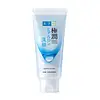What's inside
What's inside
 Key Ingredients
Key Ingredients

 Benefits
Benefits

 Concerns
Concerns

 Ingredients Side-by-side
Ingredients Side-by-side

Glycerin
HumectantPotassium Cocoyl Glycinate
Water
Skin ConditioningPropanediol
SolventCitric Acid
BufferingPotassium Chloride
Glycol Distearate
EmollientCoconut Acid
CleansingCaprylic/Capric Glycerides Polyglyceryl-10 Esters
EmollientPotassium Cocoate
EmulsifyingPhytosteryl/Octyldodecyl Lauroyl Glutamate
Skin ConditioningChlorphenesin
AntimicrobialSodium Acetylated Hyaluronate
HumectantPhytic Acid
Sodium PCA
HumectantSodium Lactate
BufferingArginine
MaskingAspartic Acid
MaskingPCA
Humectant1,2-Hexanediol
Skin ConditioningPhenoxyethanol
PreservativeMoringa Oleifera Seed Extract
Skin ConditioningGlycine
BufferingBiosaccharide Gum-4
Skin ConditioningAlanine
MaskingHydroxypropyltrimonium Hyaluronate
Serine
MaskingDisodium Phosphate
BufferingValine
MaskingThreonine
Proline
Skin ConditioningIsoleucine
Skin ConditioningPhenylalanine
MaskingHistidine
HumectantMethylparaben
PreservativeGlycerin, Potassium Cocoyl Glycinate, Water, Propanediol, Citric Acid, Potassium Chloride, Glycol Distearate, Coconut Acid, Caprylic/Capric Glycerides Polyglyceryl-10 Esters, Potassium Cocoate, Phytosteryl/Octyldodecyl Lauroyl Glutamate, Chlorphenesin, Sodium Acetylated Hyaluronate, Phytic Acid, Sodium PCA, Sodium Lactate, Arginine, Aspartic Acid, PCA, 1,2-Hexanediol, Phenoxyethanol, Moringa Oleifera Seed Extract, Glycine, Biosaccharide Gum-4, Alanine, Hydroxypropyltrimonium Hyaluronate, Serine, Disodium Phosphate, Valine, Threonine, Proline, Isoleucine, Phenylalanine, Histidine, Methylparaben
Water
Skin ConditioningGlycerin
HumectantPalmitic Acid
EmollientLauric Acid
CleansingPotassium Hydroxide
BufferingStearic Acid
CleansingMyristic Acid
CleansingButylene Glycol
HumectantPotassium Cocoyl Glycinate
Potassium Chloride
Polyquaternium-7
Disodium EDTA
Citrus Paradisi Peel Oil
MaskingCitrus Aurantium Dulcis Peel Oil
MaskingPotassium Cocoate
EmulsifyingCoconut Acid
CleansingMethylparaben
PreservativeSodium Hyaluronate
HumectantEpilobium Fleischeri Extract
Skin ConditioningPropylparaben
PreservativeDisteardimonium Hectorite
StabilisingPotassium Sorbate
PreservativeCitric Acid
BufferingCamellia Sinensis Leaf Extract
AntimicrobialWater, Glycerin, Palmitic Acid, Lauric Acid, Potassium Hydroxide, Stearic Acid, Myristic Acid, Butylene Glycol, Potassium Cocoyl Glycinate, Potassium Chloride, Polyquaternium-7, Disodium EDTA, Citrus Paradisi Peel Oil, Citrus Aurantium Dulcis Peel Oil, Potassium Cocoate, Coconut Acid, Methylparaben, Sodium Hyaluronate, Epilobium Fleischeri Extract, Propylparaben, Disteardimonium Hectorite, Potassium Sorbate, Citric Acid, Camellia Sinensis Leaf Extract
Ingredients Explained
These ingredients are found in both products.
Ingredients higher up in an ingredient list are typically present in a larger amount.
Citric Acid is an alpha hydroxy acid (AHA) naturally found in citrus fruits like oranges, lemons, and limes.
Like other AHAs, citric acid can exfoliate skin by breaking down the bonds that hold dead skin cells together. This helps reveal smoother and brighter skin underneath.
However, this exfoliating effect only happens at high concentrations (20%) which can be hard to find in cosmetic products.
Due to this, citric acid is usually included in small amounts as a pH adjuster. This helps keep products slightly more acidic and compatible with skin's natural pH.
In skincare formulas, citric acid can:
While it can provide some skin benefits, research shows lactic acid and glycolic acid are generally more effective and less irritating exfoliants.
Most citric acid used in skincare today is made by fermenting sugars (usually from molasses). This synthetic version is identical to the natural citrus form but easier to stabilize and use in formulations.
Read more about some other popular AHA's here:
Learn more about Citric AcidCoconut Acid isn't fungal acne safe.
Glycerin is already naturally found in your skin. It helps moisturize and protect your skin.
A study from 2016 found glycerin to be more effective as a humectant than AHAs and hyaluronic acid.
As a humectant, it helps the skin stay hydrated by pulling moisture to your skin. The low molecular weight of glycerin allows it to pull moisture into the deeper layers of your skin.
Hydrated skin improves your skin barrier; Your skin barrier helps protect against irritants and bacteria.
Glycerin has also been found to have antimicrobial and antiviral properties. Due to these properties, glycerin is often used in wound and burn treatments.
In cosmetics, glycerin is usually derived from plants such as soybean or palm. However, it can also be sourced from animals, such as tallow or animal fat.
This ingredient is organic, colorless, odorless, and non-toxic.
Glycerin is the name for this ingredient in American English. British English uses Glycerol/Glycerine.
Learn more about GlycerinMethylparaben is a preservative and is a paraben. It is used to prevent the growth of fungus, mold, and other harmful bacteria. Parabens are chemicals used as preservatives in both cosmetics and food.
Methylparaben can be synthetically created. It can also be found naturally in some fruits, such as blueberries.
Oftentimes, Methylparaben is combined with other parabens to help increase the shelf life.
The safety of Methylparaben is currently being studied. While ongoing studies are looking into the safety of parabens, the results have been very mixed. Some studies have not found Methylparaben to be harmful.
Learn more about MethylparabenPotassium Chloride can be bad for oily skin and be bad for acne prone skin.
This ingredient is the potassium salt of coconut acid. Coconut acid is created by mixing fatty acids from coconut oil.
It is an emulsifier, surfactant, and cleanser. According to a manufacturer, it contains glycerin.
Potassium Cocoyl Glycinate is an amino acid-based surfactant and cleaning agent. This ingredient can be derived from animals or plants. It may also be synthetically created from fatty acids of the coconut and glycine.
Potassium Cocoyl Glycinate is a gentle surfactant. Surfactants help gather the dirt, oil, and other pollutants from your skin to be rinsed away. It is a mild cleanser and naturally produces foam.
Water. It's the most common cosmetic ingredient of all. You'll usually see it at the top of ingredient lists, meaning that it makes up the largest part of the product.
So why is it so popular? Water most often acts as a solvent - this means that it helps dissolve other ingredients into the formulation.
You'll also recognize water as that liquid we all need to stay alive. If you see this, drink a glass of water. Stay hydrated!
Learn more about Water